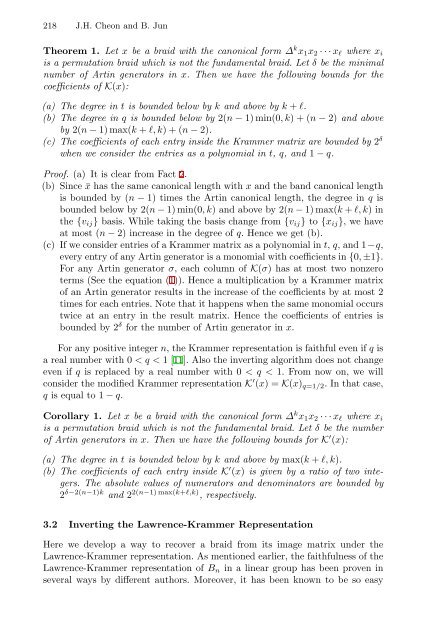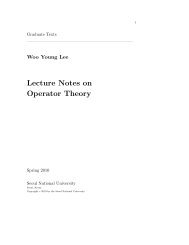A Polynomial Time Algorithm for the Braid Diffie-Hellman Conjugacy ...
A Polynomial Time Algorithm for the Braid Diffie-Hellman Conjugacy ...
A Polynomial Time Algorithm for the Braid Diffie-Hellman Conjugacy ...
Create successful ePaper yourself
Turn your PDF publications into a flip-book with our unique Google optimized e-Paper software.
218 J.H. Cheon and B. Jun<br />
Theorem 1. Let x be a braid with <strong>the</strong> canonical <strong>for</strong>m ∆ k x 1 x 2 ···x l where x i<br />
is a permutation braid which is not <strong>the</strong> fundamental braid. Let δ be <strong>the</strong> minimal<br />
number of Artin generators in x. Then we have <strong>the</strong> following bounds <strong>for</strong> <strong>the</strong><br />
coefficients of K(x):<br />
(a) The degree in t is bounded below by k and above by k + l.<br />
(b) The degree in q is bounded below by 2(n − 1) min(0,k)+(n − 2) and above<br />
by 2(n − 1) max(k + l, k)+(n − 2).<br />
(c) The coefficients of each entry inside <strong>the</strong> Krammer matrix are bounded by 2 δ<br />
when we consider <strong>the</strong> entries as a polynomial in t, q, and 1 − q.<br />
Proof. (a) It is clear from Fact 2.<br />
(b) Since ¯x has <strong>the</strong> same canonical length with x and <strong>the</strong> band canonical length<br />
is bounded by (n − 1) times <strong>the</strong> Artin canonical length, <strong>the</strong> degree in q is<br />
bounded below by 2(n − 1) min(0,k) and above by 2(n − 1) max(k + l, k) in<br />
<strong>the</strong> {v ij } basis. While taking <strong>the</strong> basis change from {v ij } to {x ij },wehave<br />
at most (n − 2) increase in <strong>the</strong> degree of q. Hence we get (b).<br />
(c) If we consider entries of a Krammer matrix as a polynomial in t, q, and 1−q,<br />
every entry of any Artin generator is a monomial with coefficients in {0, ±1}.<br />
For any Artin generator σ, each column of K(σ) has at most two nonzero<br />
terms (See <strong>the</strong> equation (1)). Hence a multiplication by a Krammer matrix<br />
of an Artin generator results in <strong>the</strong> increase of <strong>the</strong> coefficients by at most 2<br />
times <strong>for</strong> each entries. Note that it happens when <strong>the</strong> same monomial occurs<br />
twice at an entry in <strong>the</strong> result matrix. Hence <strong>the</strong> coefficients of entries is<br />
bounded by 2 δ <strong>for</strong> <strong>the</strong> number of Artin generator in x.<br />
For any positive integer n, <strong>the</strong> Krammer representation is faithful even if q is<br />
a real number with 0













